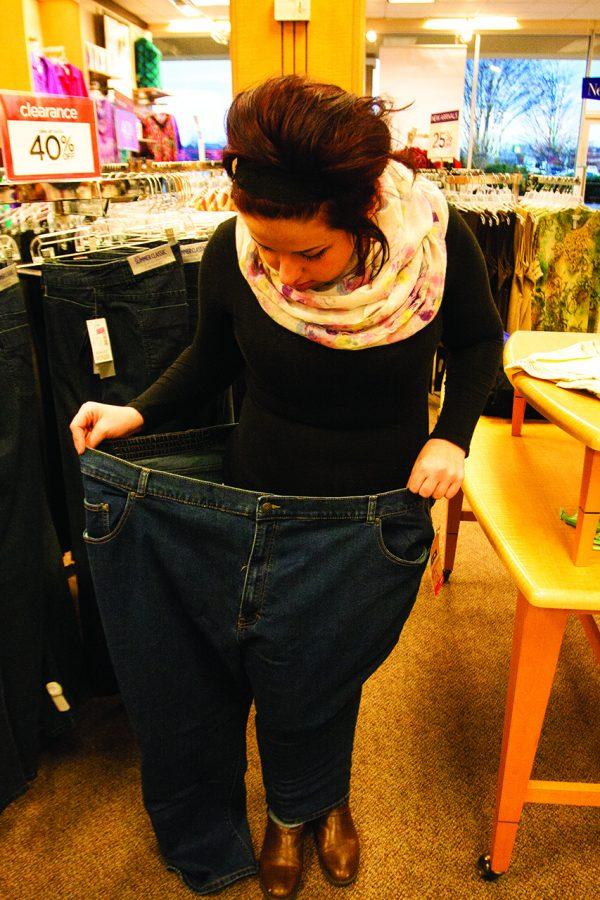Fashion industry forces unrealistic expectations on women
January 30, 2014
Recently the magazine Cosmopolitan published an article where they casually referred to size 10 model Robyn Lawley as plus size and the Facebook realm swiftly exploded in uproar with 20,118 shares on Facebook.
Currently, 447 people have left their own comments on the article.
In this situation the problem is that there are no standard sizes for women in the fashion industry, said Jane Wilson, associate professor of Human Environmental Sciences. Men have their standard sizing, but women do not, she said.
“You don’t see plus size models anywhere unless it says ‘plus-size clothing,’ but it kind of makes everyone feel like they have to lose weight and be this skinny to be able to shop here or buy this,” said Haleigh Bain, employee at Impulse Boutique in Regency Square Mall. “I mean our store has plus size clothing but most of our store only goes up to a large.”
According to the Center for Disease Control and Prevention the average woman in America weighs 165 pounds which would put her in a size 12 or 14.
“I’ve noticed too that we are getting bigger,” Wilson said. “Whether it’s because our food or our additives to our food it seems like we’re getting bigger and I think if you look around we find comfort in that we’re all kind of getting bigger and therefore it’s more acceptable.”
The fashion industry isn’t being smart and sinking the self-esteem of women who wear above size 16, Wilson said. They are not doing plus size women any favors by saying that size eight is plus size – but that’s just a part of the industry, she said.
“Fashion models are just bean poles,” Wilson said. “They really have very little shape to them. It seems like they’re getting straighter and straighter, that way (designers) can just throw absolutely anything on (models). They don’t have to be fitted because there is nothing to fit.”
Plus size models begin at size eight and up, according to Cosmopolitan.
“People are offended because they don’t think a size eight is plus size,” said sophomore T’Ebonie Tanner. “It is curvy but curvy is beautiful.”
When asking her students whether they were offended by the article, Wilson said they claimed it did not faze them. They did not feel any pressure to try and be slim to compare themselves to models who wear a size zero, Wilson said.
“They (students) feel better and they know that they look better if they have some roundness to them to look like women instead of just skeletons,” Wilson said.
The fashion industry influences people by brainwashing them into thinking skinny is the only socially acceptable body type, Tanner said.
“It’s either skinny or plus size there’s no in-between,” Tanner said.
In the past, a person was glorified for being heavier because it meant that they had more money, said freshman Kaitlin Douglass.
In today’s society thin is constantly hyped, she said. Being healthy the right way often times can require one to buy expensive organic foods and gym memberships that are not cheap, Douglass said.
“Women end up thinking they have to look like the models in magazines and men think that women should look like that,” Douglass said. “If you saw that airbrushed woman casually walking down the street you wouldn’t even know who she was.”
Magazines are unfair to women because they manifest an illusion of what women actually look like, Douglass said. Women have cellulite, stretch marks, freckles and all other kinds of ‘blemishes’ but you don’t see that in magazines, she said.
“I’m a size six or a size eight and I don’t think I’m plus size so it kind of did bother me,” Bain said. “Whenever I think of a plus size person I think of 14, 16, 18 not just six or eight that’s just everybody. [The] average person is a size six and under is just genetically small.”
Douglass offered an alternative solution.
“Magazines should actually print real women, not airbrushed women,” Douglass said. “People shouldn’t be ashamed because they’re too thin or too big. People shouldn’t feel bad about themselves because of their size – we shouldn’t be worried about being accepted because of how we look physically.”












